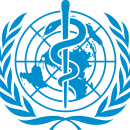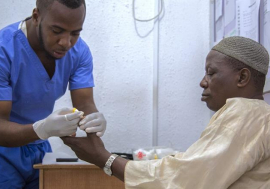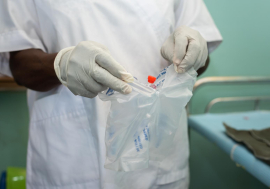As the world marks the World diabetes Day today (14 November), the World Health Organization (WHO) is highlighting the need for equitable access to essential care for people affected by diabetes and tuberculosis (TB).
Diabetes is a chronic disease that occurs either when the pancreas does not produce enough insulin or when the body cannot effectively use the insulin it produces. Insulin is a hormone that regulates blood glucose.
Hyperglycaemia, also called raised blood glucose or raised blood sugar, is a common effect of uncontrolled diabetes and over time leads to serious damage to many of the body's systems, especially the nerves and blood vessels.
In 2014, 8.5% of adults aged 18 years and older had diabetes. In 2019, diabetes was the direct cause of 1.5 million deaths and 48% of all deaths due to diabetes occurred before the age of 70 years. Another 460 000 kidney disease deaths were caused by diabetes, and raised blood glucose causes around 20% of cardiovascular deaths (1).
Between 2000 and 2019, there was a 3% increase in age-standardized mortality rates from diabetes. In lower-middle-income countries, the mortality rate due to diabetes increased 13%.
By contrast, the probability of dying from any one of the four main noncommunicable diseases (cardiovascular diseases, cancer, chronic respiratory diseases or diabetes) between the ages of 30 and 70 decreased by 22% globally between 2000 and 2019.
Symptoms
Symptoms of diabetes may occur suddenly. In type 2 diabetes, the symptoms can be mild and may take many years to be noticed.
Symptoms of diabetes include:
- feeling very thirsty
- needing to urinate more often than usual
- blurred vision
- feeling tired
- losing weight unintentionally
Over time, diabetes can damage blood vessels in the heart, eyes, kidneys and nerves.
People with diabetes have a higher risk of health problems including heart attack, stroke and kidney failure.
Diabetes can cause permanent vision loss by damaging blood vessels in the eyes.
Many people with diabetes develop problems with their feet from nerve damage and poor blood flow. This can cause foot ulcers and may lead to amputation.
Type 1 diabetes
Type 1 diabetes (previously known as insulin-dependent, juvenile or childhood-onset) is characterized by deficient insulin production and requires daily administration of insulin. In 2017 there were 9 million people with type 1 diabetes; the majority of them live in high-income countries. Neither its cause nor the means to prevent it are known.
Type 2 diabetes
Type 2 diabetes affects how your body uses sugar (glucose) for energy. It stops the body from using insulin properly, which can lead to high levels of blood sugar if not treated.
Over time, type 2 diabetes can cause serious damage to the body, especially nerves and blood vessels.
Type 2 diabetes is often preventable. Factors that contribute to developing type 2 diabetes include being overweight, not getting enough exercise, and genetics.
Early diagnosis is important to prevent the worst effects of type 2 diabetes. The best way to detect diabetes early is to get regular check-ups and blood tests with a healthcare provider.
Symptoms of type 2 diabetes can be mild. They may take several years to be noticed. Symptoms may be similar to those of type 1 diabetes but are often less marked. As a result, the disease may be diagnosed several years after onset, after complications have already arisen.
More than 95% of people with diabetes have type 2 diabetes. Type 2 diabetes was formerly called non-insulin dependent, or adult onset. Until recently, this type of diabetes was seen only in adults but it is now also occurring increasingly frequently in children.
Gestational diabetes
Gestational diabetes is hyperglycaemia with blood glucose values above normal but below those diagnostic of diabetes. Gestational diabetes occurs during pregnancy.
Women with gestational diabetes are at an increased risk of complications during pregnancy and at delivery. These women and possibly their children are also at increased risk of type 2 diabetes in the future.
Gestational diabetes is diagnosed through prenatal screening, rather than through reported symptoms.
Impaired glucose tolerance and impaired fasting glycaemia
Impaired glucose tolerance (IGT) and impaired fasting glycaemia (IFG) are intermediate conditions in the transition between normality and diabetes. People with IGT or IFG are at high risk of progressing to type 2 diabetes, although this is not inevitable.
Prevention
Lifestyle changes are the best way to prevent or delay the onset of type 2 diabetes.
To help prevent type 2 diabetes and its complications, people should:
- reach and keep a health body weight
- stay physically active with at least 30 minutes of moderate exercise each day
- eat a healthy diet and avoid sugar and saturated fat
- not smoke tobacco.
Diagnosis and treatment
Early diagnosis can be accomplished through relatively inexpensive testing of blood glucose. People with type 1 diabetes need insulin injections for survival.
One of the most important ways to treat diabetes is to keep a healthy lifestyle.
Some people with type 2 diabetes will need to take medicines to help manage their blood sugar levels. These can include insulin injections or other medicines. Some examples include:
- metformin
- sulfonylureas
- sodium-glucose co-transporters type 2 (SGLT-2) inhibitors.
Along with medicines to lower blood sugar, people with diabetes often need medications to lower their blood pressure and statins to reduce the risk of complications.
Additional medical care may be needed to treat the effects of diabetes:
- foot care to treat ulcers
- screening and treatment for kidney disease
- eye exams to screen for retinopathy (which causes blindness).
Equitable access to care is essential to ending TB, as highlighted in WHO’s End TB Strategy and reinforced in the political declarations of the United Nations high-level meetings on the fight against TB in 2018 and 2023.
According to the 2023 WHO Global TB Report, diabetes is one of the key determinants of TB, with just under 400,000 TB episodes attributable to diabetes worldwide.
People with diabetes are at higher risk of developing TB and are more likely to experience poor TB treatment outcomes, including death. This emphasises the need for ensuring access to comprehensive care for people affected by both diabetes and TB.
Providing comprehensive people-centred services for people with TB and diabetes often requires collaborative action across different health programmes.
To support this collaboration and to facilitate integrated care for people with TB and comorbidities, including diabetes, WHO published the Framework for Collaborative Action on TB and Comorbidities in 2022.
The framework includes actions to improve collaboration across respective programmes addressing TB and diabetes, and across sectors to deliver essential care for people with both conditions.
WHO’s Multisectoral Accountability Framework for TB reinforces the importance of collaboration across sectors to end the global TB epidemic.
WHO is in the process of developing an operational handbook on TB and diabetes, to provide practical guidance on the implementation of current recommendations on TB and diabetes.
“Equitable access to essential care for people with TB and diabetes is something that we must strive for. Optimal management of both conditions has the potential to improve health outcomes, including TB treatment outcomes and health related quality of life," said Dr. Tereza Kasaeva, Director of WHO’s Global Tuberculosis Programme.
She added: "The political declaration of the UN high-level meeting on the fight against TB recognises the fundamental importance of addressing the drivers of the TB epidemic, including diabetes, underlining that equitable access to screening, prevention, treatment and co-management is essential."
Dr. Bente Mikkelsen, Director of WHO’s Department for Noncommunicable Diseases emphasised, “As we mark World Diabetes Day, WHO has been calling for equitable access to essential care for people with diabetes. Given that people with diabetes are at higher risk of developing TB, this is especially important, and we call on all programmes and partners to channel their efforts into making equitable access a reality for all.”
At the United Nations high level meeting on the fight against TB held in New York in September 2023, Member States committed to enabling universal access to quality TB services as well as actions to address all TB determinants and drivers, such as non-communicable diseases, including diabetes.
They also committed to systematic screening, prevention, treatment and care of TB and for related health conditions, including diabetes, firmly reflecting the theme of this year’s World Diabetes Day “equitable access to essential care.”
The political declaration arising from the United Nations high level meeting on universal health coverage, also held in New York in September 2023, reinforces this message by advocating for strengthened efforts to address the health needs of all people, in the context of universal health coverage.
Ambitious targets related to the diagnosis of at least 80% of people with diabetes and good control of glycaemia for 80% of those diagnosed, were also endorsed by Member States at the World Health Assembly in 2022.
Given that diabetes one of the key determinants of TB, achievement of these targets will also contribute to ending TB.
The facts:
- Globally, an estimated 422 million adults were living with diabetes in 2014, compared to 108 million in 1980.
- The global prevalence of diabetes has nearly doubled since 1980, rising from 4.7% to 8.5% in the adult population.
- This reflects an increase in associated risk factors such as being overweight or obese. Over the past decade, diabetes prevalence has risen faster in low and middle-income countries than in high-income countries.
- Diabetes is a major cause of blindness, kidney failure, heart attack, stroke and lower limb amputation.
- Healthy diet, physical activity and avoiding tobacco use can prevent or delay type 2 diabetes.
- In addition, diabetes can be treated, and its consequences avoided or delayed with medication, regular screening and treatment for complications.
- In 2007 General Assembly adopted resolution 61/225 designating 14 November as World Diabetes Day. The document recognized “the urgent need to pursue multilateral efforts to promote and improve human health and provide access to treatment and health-care education.”
- The resolution also encouraged Member States to develop national policies for the prevention, treatment and care of diabetes in line with the sustainable development of their health-care systems.
Access to diabetes care
The theme for World Diabetes Day 2021-23 is access to diabetes care.
100 years after the discovery of insulin, millions of people with diabetes around the world cannot access the care they need. People with diabetes require ongoing care and support to manage their condition and avoid complications.
The centenary of the discovery of insulin presents a unique opportunity to bring about meaningful change for the more than 460 million people living with diabetes and the millions more at risk.
United, the global diabetes community has the numbers, the influence and the determination to bring about meaningful change. We need to take on the challenge.
Background
Diabetes is a chronic disease, which occurs when the pancreas does not produce enough insulin, or when the body cannot effectively use the insulin it produces. This leads to an increased concentration of glucose in the blood (hyperglycaemia).
Type 1 diabetes (previously known as insulin-dependent or childhood-onset diabetes) is characterized by a lack of insulin production.
Type 2 diabetes (formerly called non-insulin-dependent or adult-onset diabetes) is caused by the body’s ineffective use of insulin. It often results from excess body weight and physical inactivity.
Gestational diabetes is hyperglycaemia that is first recognized during pregnancy.
Every five seconds one person develops diabetes...every 10 seconds one person dies of diabetes...every 30 seconds a limb is lost to diabetes.
























